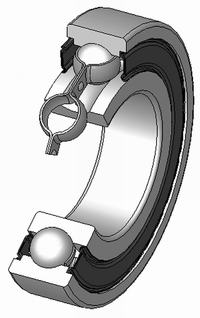
Photo from wikipedia
Abstract Introduction Surface and subsurface defects were easily induced during abrasive machining process of optical crystals due to their high brittleness. Accurate characterization of these defects is the prerequisite for… Click to show full abstract
Abstract Introduction Surface and subsurface defects were easily induced during abrasive machining process of optical crystals due to their high brittleness. Accurate characterization of these defects is the prerequisite for obtaining optical components with high surface integrity. Objectives This work aims to evaluate subsurface defects of CaF2 single crystals induced by abrasive machining, the mappings between micro cracks and diffraction pattern curves, and the influence of micro cracks on lattice structures. Methods Molecular dynamics simulation, grazing incidence X-ray diffraction experiments and cross-sectional TEM detection were used in this work. Results In grazing incidence X-ray diffraction (GIXD) detection experiments on lapping and polished specimens, shifts phenomenon of the peak position under the non-theoretical grazing incidence angle indicated that the subsurface was damaged to a certain extent. The micro cracks of the subsurface were evaluated by the consistent characteristic of “peak drift” of the diffraction pattern curve in both experiments and simulations. In addition, cross-sectional TEM results showed that regular micro cracks were found on the subsurface, which agreed well with the simulation results. Conclusion The subsurface defects of CaF2 single crystals induced by abrasive machining, and the influence of micro cracks on lattice structures can be evaluated by molecular dynamics simulation. The simulation results revealed the mappings between the micro cracks and diffraction pattern curve, which demonstrated that a phenomenon of “peak drift” occurred near the diffraction angle of a specific crystal plane. This work provided a novel technology for the nondestructive testing of defects of single crystal materials at nano- and micro- scales.
Journal Title: Journal of Advanced Research
Year Published: 2021
Link to full text (if available)
Share on Social Media: Sign Up to like & get
recommendations!